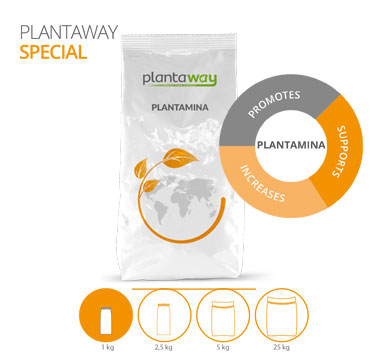
PLANTAMINA
| Analysis | (w/w) |
| Total Nitrogen | 13% |
| Nitrate Nitrogen | 6,3% |
| Ammonium Nitrogen | 2,2% |
| Ureic Nitrogen | 4,5% |
| Water Soluble P2O5 | 8% |
| Water Soluble K2O | 21% |
| Water Soluble MgO | 2% |
| Cu (EDTA Chelated) | 0,08% |
| Fe (EDDHA-EDTA Chelated) | 0,2% |
| Mn (EDTA Chelated) | 0,1% |
| Zn (EDTA Chelated) | 0,01% |
| Stable pH range for chelates | 4 - 10 |
Plantamina, when applied during the period of seedling, accelerates photosynthesis and provides necessary raw substance. As a result of this; development of the leaf, flower, fruit and root of the plant accelerates. These developed parts of the plant become more resistant against environmental factors at the same time. It enables pollination organs to become more active and healthier when the flowers are formed.In this way, the chance of pollination and formation speed of the pollinated fruits increase. When it is applied during the early times of the fruit, after pollination, it accelerates development of the fruit directly as it is highly quickly received to the structure of the plant.
This period is the time that the colour and quality of fruits are determined. Consequently, there will not be any problems relating to the colour of the fruits in the future due to the facts that Plantamina nourishes fruits directly; it enables colour pigment to become appropriate; it, increases the resistance of the plant against external factors. Moreover, there will not be any problems concerning the quality of thefruit as it helps fruit to grow quickly and it provides necessary nutriments for hormonal balance. When Plantamina is applied to the roots through the soil, it affects the biological, chemical and physiological structure of the soil. Even if the roots are so few in numbers or so tiny, it immediately begins to receive the nutriment as soon as it is interacted with soil. Thus, the development and function of the plant increase.
Consequently secretion of hormones increase after the receipt of the water and food through the soil accelerates. Thanks to these factors Plantamina provides healthy development of the plant and its roots even in very cold periods. The special quality lichens contain cytokine (zeatin). Natural Extracts accelerate the division of the cells; regulate nucleic acids, prevent the formation of the offshoot tips, they encourage side branching. It also alert buds; increase sprouting; ease the transmission of the nutriments; they delay aging and fall of the leaves. It is applied 3 or 4 times in the amount of 250gr /100 lt as of the planting until the harvest.
Application and dosage: Citrus Trees: 2 or 3 times in the amount of 200 - 250 gr/100lt at intervals of 10 tens after June fall. Stone Fruits, Apple and Pear: 2 or 3 times in the amount of 200 - 250 gr/100lt during the fruit development period. Vineyards: 2 or 3 times in the amount of 200 – 250 gr/100lt as of the sour grape period until the harvest. Wheat and Soy Bean: 100 – 150 gr/ 100lt during the formation of spike and broad beans. Peanuts, Potatoes: 2 or 3 times 200 - 250gr/100 lt during the tuber period for potatoes and stuffing period for peanuts. Tomatoes, Pepper, Aubergine, Melon, Watermelon: 2 or 3 times in the amount of 200 - 250 gr/100lt as of the constitution of the fruit until the harvest. Compatibility: It could be mixed with all types of agricultural drugs and fertilizers apart from the ones which show reaction to copper, sulphur and alkaline.However, a pre-miscibility test in tiny amounts is advised to carry out before applying. Package: 1kg, 2,5kg, 5 kg, 25 kg